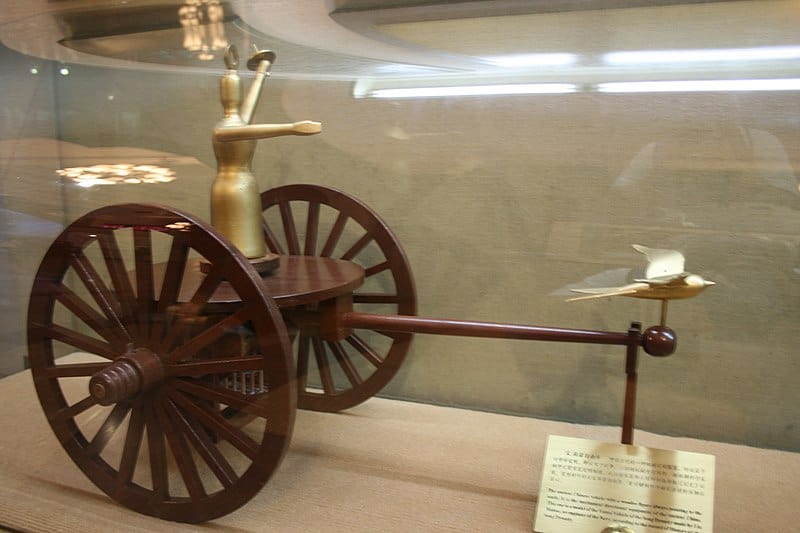While many of our most essential and frequently used devices were invented in the past couple of centuries and are continually improved to bring them to where they are today, some were conceptualized far earlier than just the 19th century. As a matter of fact, some — such as the earliest forms of what would eventually become the compass — were invented as far back as the B.C. era. Take the south-pointing chariot, for example. Legend states that the first iterations of this invention date all the way back to nearly 4,000 years ago. Let’s take a deeper look at the history of the south-pointing chariot to see how it came to be and what significance it had in the centuries that followed.
South-Pointing Chariot History
A big question mark lingers above the one true origin of the south-pointing chariot. In truth, there are a few possible starting points for this Chinese chariot. The first (and earliest) states that the Yellow Emperor (Huang Di or Ti, depending on the spelling) invented the south-pointing chariot around 2634 B.C. in order to guide his troops out of the enemy’s smokescreen in battle. Legend states that the Yellow Emperor used the mechanical vehicle to finally defeat his enemies once and for all. Another legend says that the south-pointing chariot was actually constructed around 1030 B.C. by the order of the Duke Wen of Zhou, who gave five such devices (called Chih-Nan) to ambassadors of Yüeh-Shang to get them back home.
Quick Facts
- Created
- As early as 2634 B.C.
- Creator
- The Yellow Emperor, the Duke Wen of Zhou, or Ma Jun, depending on the legend
- Original Use
- To discern the southern cardinal direction
- Cost
- N/A

The reliability of these earlier accounts remains up for debate. The oldest surviving trustworthy account comes from Fu Xuan, a 3rd-century politician, scholar, and writer who detailed Ma Jun’s invention. However, the most commonly cited origin of the south-pointing chariot comes from the Song Dynasty’s historical text, the Song Shi. This historic record says that the invention of the south-pointing chariot actually began with the invention of the odometer, used to track distance traveled. After this, sometime in the early 12th century, the design of the odometer was combined with what was known about the south-pointing chariot’s mechanical vehicle. Thus, the Song Dynasty had invented the Chinese chariot.
South-Pointing Chariot: How It Worked
While its true origins are up for debate, the mechanics of the Chinese chariot remain more or less the same across the board. The south-pointing chariot was a mechanical vehicle that indicated the southern cardinal direction. For this description, we’ll rely on the Song Dynasty’s iteration.
In most descriptions, the chariot was described as a horse-drawn cart with a man or figure placed on top to point south with an outstretched arm no matter which way the cart is drawn. Hypothetically, the chariot could travel in curves, loops, and even backward, while the person or statue would continue to point south. Of course, as stated above, this only worked if the ground surface was flat and the wheels didn’t slip (which was rarely ever the case).
It is believed that most, if not all, south-pointing chariots worked with differential gears: an assembly of gears, currently used in almost all vehicles, with three shafts that link to a single gear for each wheel. The gears kept the rotation speed of the first shaft proportional to the sum of the rotation speeds of two others. The differential mechanism of the chariot had four wooden gears, arranged in a similar way to the differential gear of an automobile. Additional gearing was also required to connect the differential to the wheels. The wheels drove the gears, which in turn rotated the pointing statue or person to keep them aimed in the southern cardinal direction. The differential motion of the wheels drove the gears, which in turn caused the statue to rotate at the same angle as the carriage turned, just in the opposite direction.
It’s important to note that, unlike a compass, which has a magnetized needle that automatically lines up with the Earth’s magnetic field, the south-pointing chariot had to be set manually at the beginning of each trip. The man or figure that served as the pointer would continue to point south throughout the journey as the device’s mechanism counteracted each turn.

When Did the South-Pointing Chariot Fall Out of Use?
While Chinese scholars learned how to magnetize iron needles as early as the Tang dynasty (7 – 8th century CE), they didn’t begin using magnetic compasses in earnest until the 11th century. At that time, according to many ancient Chinese texts, south-pointing chariots were still being made and used, at least on occasion, until around 1300.
South-Pointing Chariot: Historical Significance
The south-pointing chariot proved to be one of the earliest steps on the long road to the first Chinese compass. While the mechanical vehicle didn’t have any magnets and was incapable of truly detecting which direction was actually south, the idea behind the invention — a mechanism that rotated the pointer as the chariot moved in an attempt to keep the pointer constantly aimed southward — played a direct role in the later invention of the compass. While compasses use magnets to stay fixed northward, the idea is more or less there with the south-pointing chariot (albeit a lot more prone to simple human error).
Up Next…
- Heron of Alexandria (Hero) – Complete Biography, History and Inventions: Learn about Heron of Alexandria and his many inventions – including a steam turbine!
- Astrolabe: Discover this precursor to the sextant – invented by ancient Arab astronomers!
- Philon of Byzantion – Biography, History and Inventions: Who knew that the piston and the air pump were invented by this ancient Greek inventor? Learn more!